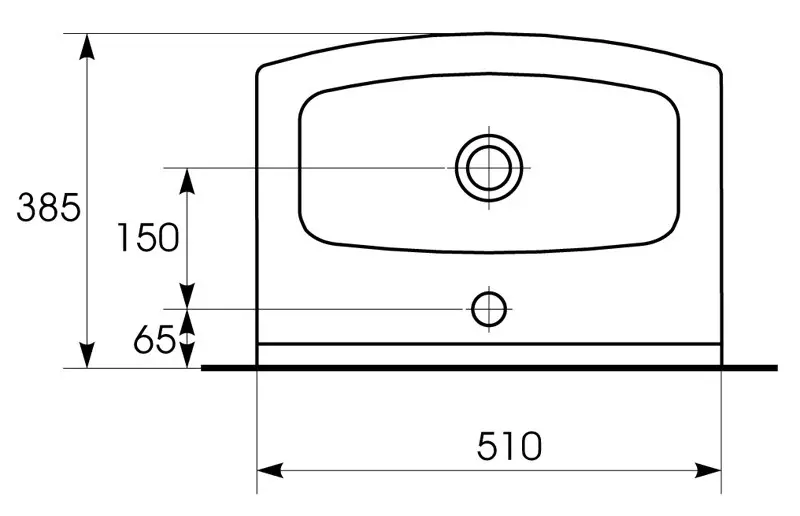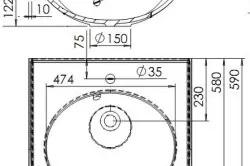Sinks: species and purpose
Sinks are a group of sanitary devices intended for collecting and draining wastewater.

Drawing of cabinet sinks.
There are several types of shells: baths, toilets, washbasins, washing.
The difference in species is due to the target destination. Baths are used to wash the entire body, these are large spacious shells. Washbasins - for washing individual parts of the body. Washings - for washing of household objects (dishes, vegetables). To the question than the sink differs from the washbasin, it can be answered like this: sinks - a common name for all stock capacities, and washbasins are a view of household shells.
The washbasin is designed to wash individual parts of the human body. Traditionally, for hands and face it is installed in the bathroom. The bidet is also a washbasin (for personal hygiene). In the children's healing camps on the street installed washbasins for legs. Often we are in everyday life call the term "washing" that item that washes something very polluted - legs, vegetables, dishes. Sometimes in the kitchen, the sink is called the "Hander", and very dirty hands are presented, which must be washed after work in the garden or kneading the test.
Washbasins: Materials and types
Materials for washbasins

Mounting washbasin scheme.
A modern bathroom washbasin can be a real masterpiece of art.
For materials used for the manufacture of different shells, 2 basic requirements are presented: water resistance and strength. In the presence of these properties, the aesthetics of the species, demand for care, cost is considered.
Washing sinks made of ceramics were the greatest distribution. They are rather durable at careful handling. However, the washbasin can crash or give a crack when hitting a severe item in it). Ceramic materials for the manufacture of shells: porcelain and faience, Sanfarfore and Sanfayans. The first 2 are quite expensive, the second 2 material is cheaper, while their quality and appearance are not inferior to the first. Other materials for manufacture: stone, glass and composites.
Article on the topic: How to install a Chinese metal door: features
Stone washbasins are the most expensive and luxurious, they are made of natural or artificial stone (marble, granite or onyx). Artificial marble has some advantages over natural material. It is not only cheaper, but also has a smoother surface, less requires care and cleaning.
Transparent glass washbasins are the most modern mass-produced shells. They are made of shockproof glass.

Wide washbasin drawing.
Composite materials are distinguished by increased strokes. Composite from acrylic (binder material) and filler (stone crumb) are manufactured.
Metal washbasins practically came out of use in bathrooms.
Very original can be called wobbies made of wood. For their manufacture and operation, periodic impregnation with a water-repellent substance is necessary.
Types of washbasins
Today there are several main types of washbasins for bathrooms. The differences between them consist in fastening methods. By type of fixture when installing them, they are divided into suspended (consoles), outdoor ("tulips" and "basins") and furniture (built-in sinks). Each view has its own advantages. Suspended washbasins - consoles are usually small (to reduce the weight of the design), they occupy the minimum possible place, allow you to save the space of the bathroom. Drinking water and drain pipes are mounted inside the wall: on the one hand it saves space, on the other, it increases the cost of installation.Outdoor washbasins are located on the support: they are easier to install, there may be large size and weight. Tulips washbasins stand on an unbroken leg, in which pipes and other possible communications are hidden. The design "Tazik" is distinguished by extravagance. Capacity stands on a flat tabletop, like on the shelf. The shape of the wash tanks (cube, ball, cone) dramatically stands out on the plane of the table, this creates an unusual appearance and the feeling that the sink can be simply taken and move.
Article on the topic: Window opening in a brick and wooden wall
Furniture washbasins have additional amenities, they are built into the table or in a furniture bathroom complex, the lockers, shelves for storing small bathrooms are mounted. Also in the furniture washbasins it is convenient to place all connecting communications inside the cabinet.
Washing - varieties and installation methods
Kitchen sinks are used for washing objects that are not related to human body (mainly dishes, vegetables). In everyday life and washing, and a washbasin, and the bath can be used as a haunted man - where closer, there is arms and wash. Modern kitchen sinks are most often made of stainless steel - steel with nickel and chromium content.
By the installation method, the kitchen sink can be a mortise or invoice. Cutting sinks are installed in the tabletops of kitchen heads. The variety of forms of mortise washes is due to the fact that in the table top you can cut any required perimeter. The overlaid washing in the installation is easier to cut. It puts on top of the finished kitchen cabinet (usually rectangular shape). In addition, its value is significantly less.
Variety of kitchenware structures please buyers. One-, two- and multi-chamber washes, angular and installation along the wall, rectangular, round and oval, washing with an additional water filter, washing with an additional cork and a drain filter, various in depth, dimensions, wall thickness.
In today's market there is a huge variety of different shells: and washbasins, and kitchen sinks. Choice for the buyer.
